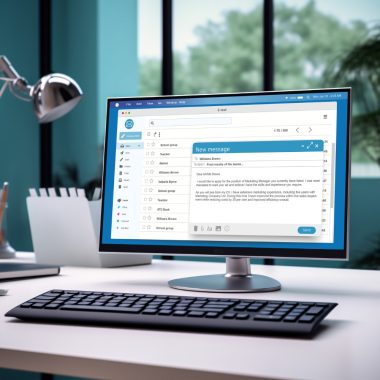In today’s digital landscape, mobile compatibility has emerged as a cornerstone of online strategy for businesses, blogs, and any form of digital content. This shift from being an optional luxury to a fundamental necessity reflects the growing reliance on mobile devices for daily internet activities.
Understanding the critical importance of mobile compatibility and its impact on digital success is more vital than ever. Let’s delve deep into why mobile compatibility holds such significance in our connected world.
The Surge in Mobile Usage
Over recent years, there’s been a significant pivot in how users access the internet, moving from desktops and laptops to smartphones and tablets. This trend is underscored by statistical reports indicating a continuous rise in mobile internet traffic.
As a result, mobile compatibility has become a decisive factor in a website’s ability to attract and retain user attention. The sheer volume of mobile users now dictates that websites must cater to this audience to remain relevant and accessible.
User Experience (UX)
Mobile compatibility directly influences the user experience (UX), a critical component for online success. A mobile-optimized website provides smooth navigation, quick loading times, and clear content presentation—key elements for user satisfaction.
Conversely, a site that fails to perform well on mobile devices can frustrate users, leading to higher bounce rates and lost opportunities for engagement and conversion.
SEO Implications
Search engines like Google have recognized the shift towards mobile browsing and have adjusted their algorithms accordingly. Mobile-first indexing, for example, prioritizes the mobile version of a website for ranking purposes.
This means that a site’s mobile compatibility is not just a user convenience factor but a crucial component of search engine optimization (SEO). Websites that are not mobile-friendly can expect to see a decline in their search engine rankings, making them less visible to potential visitors.
Competitive Advantage
In a crowded online marketplace, offering a superior mobile experience can set a website apart from its competitors. Users are more likely to return to and recommend sites that are easily accessible and navigable on their mobile devices.
Therefore, investing in mobile compatibility is not just about avoiding disadvantages; it’s about seizing an opportunity to distinguish your online presence.
Social Media Integration
The explosion of social media usage on mobile devices further amplifies the need for mobile-compatible websites. With the majority of social media browsing occurring on smartphones, the links shared within these platforms must lead to mobile-friendly pages.
Failing to provide a seamless transition from social media to a mobile-compatible site can disrupt the user journey and diminish the effectiveness of social media marketing efforts.
Adaptation to User Behavior
Mobile compatibility acknowledges and adapts to the evolving user behavior. The convenience of smartphones has led to varied browsing habits, including on-the-go searches, last-minute shopping, and the consumption of news and entertainment.
A mobile-compatible website caters to these spontaneous and diverse user needs, ensuring that the content is always accessible, regardless of the device used.
E-commerce Growth
For e-commerce sites, mobile compatibility is even more critical. The rise of mobile commerce (m-commerce) means that a significant portion of online shopping now occurs on mobile devices.
A seamless mobile shopping experience can directly influence purchase decisions, highlighting the direct link between mobile optimization and revenue generation.
The importance of mobile compatibility cannot be overstated in an era where mobile devices dominate internet access. It affects everything from user experience and SEO to competitive edge and e-commerce success. As mobile usage continues to grow, the emphasis on mobile-friendly design and functionality will only intensify.
For businesses and content creators alike, prioritizing mobile compatibility is not just a strategic move—it’s an essential step towards thriving in the digital age. By embracing mobile optimization, websites can ensure they meet their audience where they are, providing an accessible, engaging, and effective online experience.
As we delve deeper into the significance of mobile compatibility, it becomes clear that this is not merely a technical requirement but a fundamental shift in how digital experiences are crafted and delivered. The ongoing evolution of mobile technology and user expectations demands a proactive approach to mobile optimization, emphasizing the need for continuous improvement and innovation.
Future-Proofing Your Online Presence
The pace at which mobile technology evolves is staggering. New devices, screen sizes, and operating systems emerge regularly, each posing unique challenges and opportunities for online content delivery.
By prioritizing mobile compatibility, websites can better future-proof their online presence, ensuring they remain adaptable to the ever-changing digital landscape. This adaptability is crucial for maintaining relevance and engagement with an increasingly tech-savvy audience.
Enhancing Accessibility
Mobile compatibility also plays a vital role in enhancing accessibility. By designing websites that are easily navigable on mobile devices, content creators and businesses can reach a wider audience, including those with disabilities or limitations that make traditional computer use challenging.
Mobile-optimized sites often incorporate responsive design principles, which improve accessibility by making content flexible and adaptive to various screen sizes and input methods.
Boosting Local SEO
For local businesses, mobile compatibility is especially critical. Mobile searches often have local intent, with users looking for products, services, or information available in their immediate vicinity.
A mobile-friendly website can significantly improve a business’s visibility in local search results, driving foot traffic and local online engagement. This highlights the role of mobile optimization not just in global or online markets but in connecting businesses with their local communities.
Encouraging Mobile Transactions
Beyond browsing and information gathering, the ease of completing transactions on mobile devices is a key aspect of mobile compatibility. This includes not just e-commerce purchases but also bookings, registrations, and any form of online interaction that requires user input.
Optimizing these processes for mobile users can drastically improve conversion rates, as users are more likely to complete transactions that are convenient and secure on their devices.
Leveraging Advanced Mobile Features
Finally, mobile compatibility opens up opportunities to leverage advanced mobile features, such as geolocation, biometric inputs, and augmented reality (AR). These features can create more engaging and personalized user experiences, further enhancing the value and attractiveness of mobile-optimized sites.
For example, geolocation can offer personalized content or services based on the user’s location, while AR can provide unique interactive experiences that are only possible on mobile devices.
The critical importance of mobile compatibility in today’s digital ecosystem cannot be understated. It touches every aspect of online strategy, from design and user experience to SEO, accessibility, and beyond. As mobile devices continue to be the primary means of internet access for a growing portion of the global population, the focus on mobile optimization will only intensify.
For anyone looking to succeed online, whether through business, content creation, or any digital initiative, embracing mobile compatibility is not just a strategic advantage—it’s a necessity for engaging and satisfying the modern digital user.
In sum, mobile compatibility is not just about keeping up with current trends; it’s about anticipating the future of digital engagement and positioning oneself to thrive in an increasingly mobile-centric world.
Best strategies for a better mobile compatibility
As the importance of mobile compatibility becomes ever more apparent, developing strategies to ensure your website performs optimally on mobile devices is key. Here are some of the best strategies to enhance mobile compatibility and provide a superior mobile user experience.
1. Responsive Design
Implementing a responsive design is the cornerstone of mobile compatibility. This approach ensures that your website’s layout and content adjust seamlessly to fit the screen size and orientation of the device it is being viewed on. Responsive design uses flexible grids, images, and CSS media queries to create a dynamic viewing experience that is equally accessible on desktops, tablets, and smartphones.
2. Mobile-First Approach
Adopting a mobile-first strategy involves designing your website for mobile devices before scaling up to larger screens. This approach prioritizes the needs and limitations of mobile users, such as smaller screen sizes and touch-based navigation. Designing with mobile in mind from the outset can lead to cleaner designs, improved performance, and a focus on essential content and functionality.
3. Optimize Loading Times
Mobile users expect quick loading times, and slow websites can lead to increased bounce rates. Optimizing your website’s loading times involves compressing images and videos, leveraging browser caching, minimizing HTTP requests, and using content delivery networks (CDNs).
These techniques can significantly reduce the time it takes for your pages to load, enhancing the user experience and potentially improving your SEO rankings.
4. Simplify Navigation
Mobile screens offer limited real estate, making navigation a critical consideration. Simplify your website’s navigation to make it easy for mobile users to find what they are looking for. This can include a simplified menu, a prominent search function, and clear, clickable calls-to-action (CTAs).
Ensuring that users can navigate your site effortlessly on a touchscreen can greatly enhance the mobile experience.
5. Optimize for Touch
Design your website’s elements with touch in mind. This means making buttons, links, and form fields easy to tap with a finger, avoiding elements that require precise mouse actions, which can be frustrating on a touchscreen. Additionally, ensure that interactive elements are spaced adequately to prevent accidental taps, enhancing usability.
6. Prioritize Content Hierarchy
Given the smaller screen sizes, it’s crucial to prioritize content hierarchy to ensure that the most important information is immediately visible to mobile users. This involves organizing content in a way that users can easily scan through, using headings, bullet points, and short paragraphs to break up text and make it more digestible on a small screen.
7. Test on Real Devices
While emulators and simulators can provide an approximation of how your website looks on various devices, nothing beats testing on actual hardware. Use a range of smartphones and tablets to see how your website performs in real-world conditions. This can help identify issues with touch responsiveness, layout, and other factors that might not be apparent in a simulated environment.
8. Continuous Optimization and Feedback
Mobile compatibility is not a one-time task but an ongoing process. Technologies, user preferences, and mobile devices continue to evolve, necessitating regular updates and optimizations to your website. Encourage and monitor user feedback to identify areas for improvement and stay informed about the latest mobile web development trends and best practices.
Building a website with robust mobile compatibility requires a thoughtful and strategic approach. By implementing responsive design, optimizing for speed, simplifying navigation, and focusing on user-centric design principles, you can ensure that your website provides a positive experience for mobile users.
As mobile internet usage continues to grow, these strategies will not only help you meet the current demands of mobile users but also future-proof your website for the evolving digital landscape. Remember, a mobile-compatible website is not just about meeting technical benchmarks; it’s about creating engaging, accessible, and enjoyable experiences for users regardless of the device they use.











